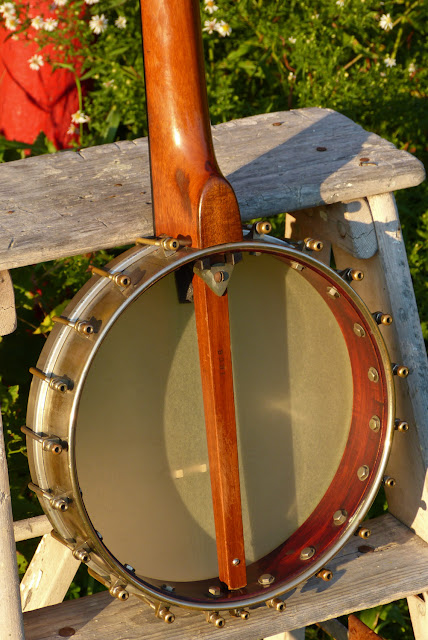1908 Weymann Openback 5-String Banjo
Update: Per comment below, I've updated the date to the year suggested by Mr. C. Check out his updated Weymann serial number list at this site.
There's no getting around it -- Weymann products (Philadelphia-made) are just darn good quality. I haven't had many around this year, but in years past (before I got overwhelmed with consignment guitars) I used to hunt for them like nuts. They're well-built, rugged, and beautifully-cut instruments -- even in simple versions like this relatively plain 5-string.
There's no getting around it -- Weymann products (Philadelphia-made) are just darn good quality. I haven't had many around this year, but in years past (before I got overwhelmed with consignment guitars) I used to hunt for them like nuts. They're well-built, rugged, and beautifully-cut instruments -- even in simple versions like this relatively plain 5-string.
Did I mention that the 5-strings are rare? It seems they were mostly made from 1900-1915 or so, after which Weymann seems to have more-or-less exclusively shifted to the ever-popular tenor banjo for most of their production. 5-strings like this one of the spunover-rim, earlier variety are hard to find. To me, this feels like a "Martin of the banjos" for the time with its quick and slim soft-V mahogany neck, slab ebony fretboard, and spare but elegant styling. The stable and practical build gives it that feel, too.
This one came in for consignment and I needed to do a bit of spiffing-up, but it was mostly in good order. I leveled/dressed the frets, knocked the neck-angle back, added a new bridge, reseated the 5th string peg, and set it up properly. It's currently strung with nylon (to replace gut which would've been normal for the time this was made), has a dead-straight neck, and plays spot-on at 3/32" action at the 12th fret. It'd previously been used with light steel and the neck was holding just fine with that, too, though I think these really come alive with the string type/tension they were designed for.
This has a 10 1/2" head (it's a newer Remo Renaissance one) and a long 26 1/4" scale length. This gives it a light and comfortable feel in the lap, though the heavy-duty hardware and sturdy rim give it good depth of tone and a lot of projection.
The rim hardware is all-original save for a few replacement (but period) hook/nuts.
The headstock has a nice, thick veneer and bone nut. The original friction pegs are still on this and work well.
Smaller pearl dots and a thicker ebony board give this a high-quality, refined look. I like the bone 5th "pip," too.
As usual for nylon-strung banjos, I've used a "minstrel-style" all-maple 3-foot bridge. It's lightweight.
Weymanns tend to have a good, rugged heel design that gives a sense of security.
Note the tiny bolt/nut I've installed through the end portion of the dowel. This Weymann had an extra-thick endbolt installed and when I was taking this apart I found that the dowel had a hairline split in it because of that. I glued it up and also installed this small bolt/nut to make sure it stays together for the future. No issue.
While the neck is mahogany, the rim appears to be stained maple. It has heavy-duty nickel-plated brass cladding that's curled-up over a bigger brass hoop on the top and bottom. This makes a "tonering" on the top edge and gives the rim greater rigidity despite the light weight.
The bit of foam helps cut down on higher overtones to clean the sound up. This has the original shim-style neck brace installed but I've also done a bit of hidden modification. Behind the ebony shims are two screws that are installed through and into the heel like on Buckbee banjos of the 1880s/90s. This gives a much more secure attachment to the rim -- especially if the next owner plans to take this out to shows and jams a lot.
The serial number is below the usual Weymann number charts and I'm approximating the age of this to around the late 1890s or early 1900s. Update, here. Mr. Charlie has supplied us with an up-to-date serial number list which places this at 1908. Click here to check it out.
This comes with a good-quality, hard, arched-lid, Superior "bump" banjo case.
























Comments
http://www.leavingthisworld.com/weymann-serial-numbers-and-dating/#111
Charlie